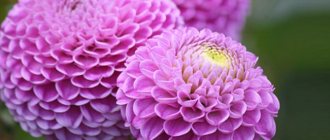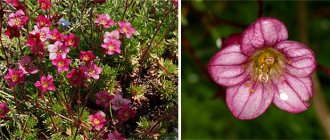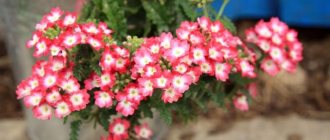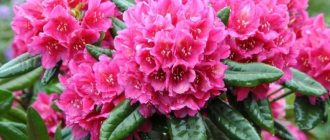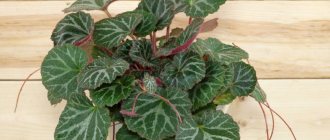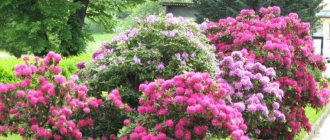Garden daisies are especially popular among Russian flower growers and landscape designers. Their popularity is explained by their visual appeal, unpretentiousness and medicinal properties. Anyone can grow a flower in their own garden plot or flower garden near their home; it is enough to know the basic rules for caring for the crop.
A distinctive feature of perennial garden chamomile is its huge buds.
Features of the flower
There are a large number of varieties of garden chamomile. Each representative of a culture has its own characteristics and external differences. But there is also a unifying feature, which is expressed by an inflorescence in the form of a basket with a yellow core and snow-white petals. The exception is colored hybrids.
Garden crops differ from their wild counterparts in the following ways:
- large buds;
- abundant and long flowering;
- the possibility of re-ovarying inflorescences.
The perennial plant belongs to the Astrov family; it stands out from its fellows with a thin stem that can reach 60 cm in height.
Bipinnate leaf plates are arranged alternately on the shoot. And at the very top there are large flowers, the size of which varies between 10-15 cm.
The distinctive features of garden chamomile are its rapid development and growth, early bud formation and long flowering, which lasts from mid-June to the end of summer.
Breeders managed to develop chamomile with semi- and double flowers, in which the petals are arranged in several rows, they look like balls
Brief information about cornflower
Nivyanik also has other names: Leukantemum, Garden chamomile, Popovnik. The herbaceous perennial plant has a long flowering period: usually from July to late autumn. Representative of the Asteraceae family.
There are low-growing varieties (up to 30 cm in height), medium-growing and tall varieties (about 60-80 cm in height). The diameter of the inflorescence is about 3-12 centimeters. Propagates well by self-sowing.
Popular plant species: Common Nivyanik (meadow chamomile) and Nivyanik greatest. There are also magnificent Nivyanik, Kuril, and hybrid varieties.
Note! It is believed that the Common Nivyanik is less demanding and easier to grow than the Largest.
The place for growing nibbles should be well lit. The plant does not tolerate shade. Garden chamomile grows best in fertile, well-drained, loose soil. Before planting a flower crop, it is recommended to prepare a poor, uncultivated area, dig it up, and apply organic fertilizers (humus or compost).
You should not choose lowlands or just areas where water accumulates. The soil should not be heavy, clayey, or waterlogged.
Garden chamomile is relatively unpretentious. Although she needs timely care, all procedures are very simple and easy to perform. In general, plants require watering; regular watering is important, especially in dry weather. However, you should not overwater the plants.
Leucanthemum also loves feeding. Especially organic fertilizers, for example, humus, mullein.
Nivyanik looks great in solitary single and group plantings. It goes well in a flower garden with cornflowers, delphinium, bluebells, and pyrethrum.
Varieties and characteristics
Chamomile has been cultivated for over 500 years. During this period of time, many new varietal representatives have appeared, but not all are popular among gardeners.
There are species that are found everywhere:
- Nivyanik is a classic perennial garden chamomile; planting and caring for it in the open ground is not difficult. The flower grows up to 70 cm, and the buds reach a diameter of 7 cm. Nivyanyak blooms for almost two months, and the first flowers appear at the beginning of the first summer month.
- Northern Star is one of the leading perennial varieties among flower growers. The plant has a high level of frost resistance and loves sun and moist soil. The variety is easy to propagate; the seeds germinate within the third week after sowing.
- Princess - low, lush bushes are suitable for planting in open ground, so they can often be found in park areas and borders. Good frost resistance allows you to decorate garden areas with flowers. The diameter of the buds is approximately 8 cm, the bushes are literally strewn with flowers.
- Pyrethrum - most representatives of this chamomile are small-flowered, the buds do not exceed 6 cm. Although there are giant specimens that grow up to 80 cm in length, and the diameter of the flowers exceeds 12 cm. These are winter-hardy and shade-tolerant varieties with long and abundant flowering.
Colored daisies are very beautiful flowers, attracting with their unusual appearance and color of the petals. They are not traditionally white, but pink, burgundy, yellow and crimson. These perennial hybrids continue to bloom throughout the season.
The most popular colored representatives are “Erigeron”, “Paradise”, “Golden Ball”.
Each variety has its own characteristics in cultivation and requirements regarding conditions. When to plant perennial chamomile depends on the age of the plant, but usually this is done every three years; it is not worth keeping the plant in one place for more than five years.
The “Princess” variety is compact in size, the height of an adult bush does not exceed 30 cm, these flowers can be grown in a flower pot
Care and conditions for growing nevberry seedlings
In order for the seeds to germinate together, and for the nevberry seedlings to grow strong and strong, it is necessary to provide optimal growing conditions and care:
- The cover or film is permanently removed after germination. Before seeds germinate, it is recommended to regularly ventilate the greenhouse, removing the cover for 15 minutes.
- After planting, it is necessary to maintain a temperature of about 22-23 degrees Celsius. After germination, you need to lower the temperature to 18-20 degrees.
- Niwberry seedlings should be regularly watered with clean, settled water at room temperature. The procedure should be carried out as the top layer of soil dries, but not more often.
- Young plants must be fully illuminated for at least 12 hours a day, so they should be immediately placed on the brightest windowsill. If there is a lack of light, it is better to use phytolamps.
- It is useful to feed young plants with complex fertilizer for seedlings. The first feeding is carried out 10 days after picking, the second - a week before planting in a permanent place.
- Picking nivaria seedlings is done at standard times: when 2-3 true leaves appear. At this stage, you should use individual cups or pots about 9-12 centimeters high. To pick, you need to carefully pick up the seedling with a wooden stick or fork, keeping the soil around the roots, and transfer the plant to a new container. The roots should lie flat and not bend. The seedling itself needs to be buried down to the cotyledon leaves, the voids filled with soil and watered abundantly.
Features of cultivation
There are no serious difficulties when growing perennial garden chamomile. She is unpretentious, so even a beginner can breed.
Sowing seeds
Sowing work is carried out taking into account the method of cultivation: there are seedlings and non-seedlings. The first option is considered more reliable.
For seedlings
Sowing of planting material for seedlings is carried out in the spring; March is considered the ideal month. Before planting daisies, prepare containers with drainage holes.
You will need nutritious soil made from peat and sand, the components are taken in equal quantities.
Then proceed like this:
- 3 seeds are placed in each hole; after planting, they are covered lightly with soil.
- The container must be covered with material; this is done to create conditions close to greenhouse conditions.
- It is strictly not recommended to keep a container with plantings on a sunny windowsill, since high intensity can damage fragile seedlings. It is also important to monitor the soil moisture level before replanting; it should not dry out.
When to replant perennial chamomile depends on the climatic conditions of the region, but this is usually done in May, during which time the soil has already warmed up.
The small bush chamomile looks very beautiful, the variety name is Pyrethrum
In open ground
Planting seeds in open flower beds occurs when the threat of frost has passed. It is best to carry out planting work in mid-May; in the south you can plant flowers a little earlier.
This is done as follows:
- shallow grooves are made in the selected area;
- holes are made at a distance of 25 cm, their depth should be approximately 15 mm;
- One seed is added to each;
- then cover the planting material with soil;
- watered with a growth stimulating agent.
Using the same scheme, you can transplant chamomile seedlings. In this case, the first buds can be expected next spring.
When sowing chamomile seeds in an open area, you need to make sure that there is no groundwater near the flowerbed. They have a bad effect on the plant.
How to plant a large garden chamomile in open ground
Before planting garden chamomile, it is imperative to prepare the soil for more efficient absorption of the shrub, regardless of how it is grown.
The most successful option for transforming any soil into a favorable environment for any variety is considered to be fertilizing with universal flower fertilizers. They can be either organic (low concentration) or mineral. Although, if you wish, you can purchase special preparations for such purposes in the store.
When and how to plant?
If the method of sowing seeds was chosen for planting, it is better to start growing in March. It’s good if you plant the seeds not in open ground, but in special containers (disposable plastic cups can be used), because there they will germinate better and be better accepted on the site.
Seedlings are planted at the beginning of May, so that the plant has time to assimilate into the new environment.
When the ground is ready, holes are dug for planting, 20-30 cm deep with indentations of 20-40 cm from each other. After planting, the plant is watered abundantly with clean water or diluted means to stimulate growth.
Chamomiles will begin to bloom within a year.
When is the best time to replant garden chamomile?
September is a good time for transplanting and dividing bushes, since an adult plant is accepted quickly and already feels comfortable in a new place by the cold weather.
Plant care rules
Caring for chamomile is not difficult; the plant is considered unpretentious, so anyone can grow it. The flowering crop is a light-loving plant; it will grow well in a nutritious, loose substrate, but it should not be transplanted to a place with groundwater.
Watering activities should not be frequent; soil should be moistened only after drying. It is important to choose the right time for the procedure: it is best to choose early morning or evening, when the sunlight is no longer so intense. Droplets of water on foliage and petals can act as a lens and cause burns.
Lush and long-lasting flowering of garden chamomile is ensured by timely feeding
A prerequisite for growing a flower is loosening and weeding the surface layer of soil. It is important to provide the crop with timely fertilization. This is done in the spring; nitrogen complexes will be the best feeding at this time.
Caring for chamomile after flowering involves the inclusion of several agrotechnical measures:
- removal of faded inflorescences, pruning is carried out directly from the stem;
- in late autumn, adult clumps are divided;
- During the same period, old dead parts of plants are pruned.
It is also important to deoxidize the soil in late autumn if necessary. To do this, add lime or dolomite flour to the flowerbed.
You should not keep border chamomile in one place for more than five years. At this age, she is already wasting her decorative appeal. The flower can be replaced with a new one or a rejuvenating procedure can be performed.
Collecting seeds
To collect seeds, you need to select several of the largest flowers. When they are completely dry, they are cut and stored in a dry place with good ventilation. When the flowers are completely dry, shake the seeds out of them onto a sheet of paper.
Seeds are stored in paper bags in a dark and dry place in winter. They will not lose their viability for three years. But you should immediately take into account that the varietal characteristics of plants grown from seeds do not retain.
Garden chamomile is a charming flower that does not require painstaking daily care. In response to a little attention and care, chamomile will thank you with bright flowers of the sun.
Reproduction methods
There are several ways that daisies reproduce. The first option is to divide the bush, which has reached three years of age, into several separate parts. Then put each one in its own separate place.
The second method of propagating chamomile involves sowing seed directly into the soil at the dacha or in the garden. But it is better to plant seedlings in open areas. The chance that the plant will adapt to the new environment in this case is much higher.
It is best to replant and divide shrubs in September.
Mature shrubs quickly take root and adapt to the new environment. In addition, they are not afraid of the cold. Transplanting in the fall will ensure the buds set in the spring, which means you won’t have to wait a whole year for the long-awaited flowering.
You can collect planting material yourself.
Instructions on how to collect chamomile seeds:
- Even in the summer, you need to choose the variety you like, the bush must be healthy and strong;
- Next you need to let the bud bloom, it should dry completely;
- wait until the core changes color from yellow to deep brown;
- it is important to wrap the flower in gauze;
- then you should press in the middle, the seeds will easily disintegrate.
After collection, the seeds are dried and removed before sowing. Planting material has a high germination rate.
Chamomile seeds look like this
Usage
The main areas of use of chamomile are cosmetology and medicine. In medicine, the flower is used in the following cases:
- menstrual irregularities;
- flatulence;
- spasms;
- internal inflammatory processes;
- dermatological diseases.
Chamomile disinfects and has a disinfectant; it is added to baths for bathing babies.
Decoctions and lotions based on the plant are used in cosmetology as restorative agents for hair, for wiping the skin with acne, inflammation and acne.
Pests and diseases
With proper care, flower growers do not encounter any difficulties, but if the rules are not followed, problems will arise regularly.
Bush daisies often suffer from the following diseases:
- Powdery mildew appears as a white coating on the stem and leaf blades. If you do not take action, the plaque soon begins to turn brown. Afterwards the plant dries out and dies. Treating parts of the flower with fungicidal preparations will help correct the situation.
- Gray rot, this problem can be identified by the brown spots that appear on the leaves and stems. At the beginning of the development of the disease, they are almost invisible, but spread quickly and can affect large areas.
- Rust on daisies, the primary sign of the disease is the presence of dark orange spots on the leaf on the front side. Fungal spores are usually found on the reverse side.
Special remedies will help get rid of fungal diseases. Fungicides called Fundazol and Kuproxat have proven themselves well.
Harmful insects are also not a rare guest on garden daisies. Most often, gardeners encounter wireworms, star-winged flies and aphids on plants. They get rid of them with the same fungicides.
Rust is easily identified by pads with fungal spores on the back of the leaf blade of daisies
Useful properties of the plant, contraindications for use
Chamomile has a number of beneficial properties, which is why it has long been used not only as a traditional medicine, but also as a natural component of many medicines.
Medicinal effects of the plant:
- choleretic;
- hemostatic;
- anti-inflammatory;
- antibacterial;
- diuretic;
- soothing;
- antispasmodic.
Chamomile flowers contain tannins, macro- and microelements, vitamins, so simple tea made from it has a beneficial effect on the immune system, strengthening the body's defenses.
Taking chamomile has contraindications:
- stomach ulcer;
- acute diseases of the genitourinary system;
- psychical deviations;
- frequent diarrhea.
There may be an allergic reaction to chamomile and its chemical components caused by individual intolerance.
Using flowers in landscape design
Garden chamomile is often found in landscape design. Most often, the perennial is used as a decoration for slides and borders. Luxurious bouquets are formed from high varieties.
The flowering crop looks very beautiful against the backdrop of garden lilies, cornflowers, and bells.
Red poppy and calendula will be good neighbors for the plant. Low bushes can become a wonderful decoration for green flower beds or paths.
And although daisies are not recognized by many (they are considered too simple and modest), today they are increasingly found in the most exquisite country compositions. If large or colored daisies are used wisely, they will become the main decoration of the flowerbed.
Botanical description
All representatives of the daisy genus have a weak but characteristic odor . The plant is widely used in folk and traditional medicine because it has antiseptic and anti-inflammatory properties. In addition, the plant can be used in landscape design and for arranging bouquets of wildflowers.
The classification of chamomile is still not streamlined . There are several systems for its description, each of which considers several dozen species of this plant. The most popular type of chamomile is Chamomile. It is this species that has the most pronounced medicinal properties.
Sometimes daisies are also called other plants that are similar in appearance to this flower. These include pyrethrum, cornflower, as well as some types of asters and chrysanthemums. And, although from a botanical point of view this is not true, all these plants are grown in approximately the same way as ordinary chamomile.
pharmaceutical camomile
Chamomile is a low herbaceous perennial plant with pinnate, dissected leaves.
The chamomile inflorescence is a semicircular basket containing several hundred small flowers. The diameter of the inflorescences ranges from 5 to 20 mm. Their center is yellow or yellow-orange in color, the outer leaves are almost always white. The structure of the inflorescence is quite interesting: in the center there are bisexual flowers, at the edges there are only flowers with pistils.
Chamomile inflorescence
Flowering begins quite early . Usually, the first inflorescences appear at the very beginning of spring, in warm areas sometimes as early as early March. Since flowering does not occur simultaneously, blooming daisies can be found even in one area throughout the entire season - from early March to late October. Peak flowering occurs between May and July. Pollination is carried out by wasps or bees.
The fruits of the plant are achenes with a pappus . Fruit ripening occurs within 1-1.5 months after the end of flowering.
Chamomile is grown to produce pharmaceutical raw materials, primarily essential oils and azulene . For this purpose, the inflorescences and tops of the plant are collected.
Preparing Leucantemella for winter
In general, Leucantemella does not require practically any preparation for winter: only regular pruning of the stems to a height of about 2-5 cm. This is done when it starts to snow and the autumn chamomile stops blooming. It is useful to mulch the remains of the bush on top.
By the way, cut winter daisies stand well in a vase, so your last bouquet of the season can be made from daisies!
Be careful in spring: Leucanthemella, like many late-autumn crops, is slow-witted and may not wake up for a long time. Calmly wait for her to appear and don’t panic. And most importantly, don’t dig it up ahead of time.


